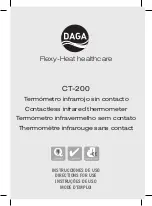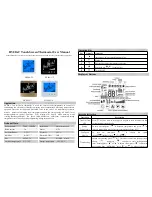
- -
34
If the read value is sufficiently close to the theoretical one, the central column reports the actual
value, at the measured temperature, of one of the four standard solutions: an arrow blinks near
the detected standard solution, displayed in the list on the right. Continue the calibration from
point 10 of the previous chapter “
Automatic calibration of conductivity using memorized stan-
dard solutions
”.
The central column reports the same value in the left column, if the calibration solution value is
too far from the four standard solutions (147
μ
S/cm, 1413
μ
S/cm,…). Continue the calibration
according to the following point:
10.
Using the arrows (
and
) set the conductivity value determined in point 6, and confirm
with “
F2 = CAL
”. The cell constant correction is displayed.
The
;
symbol is displayed over the number identifying the calibrated range. The instrument is
still in calibration mode: By pressing
“
F2 = CAL
” again, it is possible to repeat the current
calibration point to obtain a finer calibration.
11.
To end the calibration and return to measurement, press
F3 = EXIT
(step 17), or continue the
calibration for the next point.
12.
If the next calibration solution is one of the standard solutions automatically detected by
the instrument
, open the menu and re-enter the temperature coefficient as it was before the
calibration. Extract the probe from the calibration solution, wash it, clean it carefully, and insert
it in the following solution. Continue the calibration from point 10 of the previous chapter
“
Automatic calibration of conductivity using memorized standard solutions
”.
13.
If the next calibration solution is NOT one of the standard solutions automatically de-
tected by the instrument
, extract the probe from the calibration solution, wash it, clean it care-
fully, and insert it in the following solution.
14.
The instrument proposes the value of the new solution:
The previous point is captured per-
manently:
15.
Continue by repeating the steps from point 9.
16.
To end the calibration press “
F3 = EXIT
”.
17.
Open again the menu, and re-enter the temperature coefficient as it was before the calibration.
18.
Rinse the probe with water. If you are going to perform low conductivity measurements, we
recommend rinsing the probe using distilled or bidistilled water.
The instrument is now calibrated and ready for use.
If the probe is not fitted with a SICRAM module, the calibration updates the cell constant and
saves it in the instrument’s memory. If the probe is fitted with a SICRAM module, the cell
constant is saved in the probe’s memory
.
NOTES:
•
By accessing the calibration, the cell constant Kcell is set to the nominal value input in the
menu if the probe is without SICRAM, or to the value read in the memory of the probe
with SICRAM.
•
Upon confirming the calibration by using “
F2 = CAL
”, the instrument checks that the correction
to the cell constant does not exceed the
±
10% limits. If the calibration is rejected because it ex-
ceeds the
±
10% limit, the “
CAL ERROR
” message will appear, followed by a long beep. The
instrument remains in calibration mode and maintains the nominal cell constant entered manu-
ally in the menu or read from the SICRAM memory: If you leave the calibration by pressing
EXIT, the instrument will use the cell constant K nominal value.
Summary of Contents for HD2205.2
Page 78: ...78...
















































